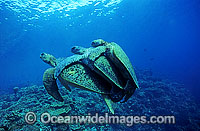
Mating
Green sea turtles Chelonia mydas
with secondary male, during
annual breeding season. |
|
Ancient reptiles of the deep, sea turtles
have long been surrounded by mystery and ignorance. Now
as a result of much research by dedicated scientists and
conservationists, our knowledge of these puzzling wild creatures
is expanding. Experts believe that obtaining a complete
picture of a turtle’s life cycle may be the key to
saving them from extinction.
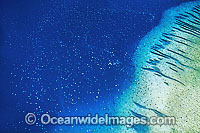 Aerial view of unusual aggregation of thousands
of Green sea turtles Chelonis mydas
waiting in the waters of Raine Island until
night fall when they will swim ashore and
lay their eggs (bottom
right). Every dot represents a turtle - to
see larger version, please register
on the Oceanwide Images website.
|
|
Green turtles were heavily exploited
in the 1920’s for turtle soup by canneries on Heron
and North-West Islands off central Queensland. Around a
thousand nesting female turtles were harvested each year
from North-West alone, almost resulting in the total decimation
of that island’s breeding population. In other parts
of the world such as the Cayman Islands, Bermuda and the
Dry Tortugas, entire populations have become extinct through
commercial exploitation by man.
Of the seven existing species of sea
turtle, six are today listed as threatened or endangered.
In 1950, green turtles became protected in Queensland and
in 1968 this legislation extended to include all turtle
species.
This summer from November through March,
the many conservationists and volunteers of the Queensland
Sea Turtle Project will make their annual pilgrimage to
the rookeries of Mon Repos and the Capricorn-Bunker Islands.
Here they will carry out important research into turtle
biology, which may bring us closer to understanding their
obscure and perplexing life cycle. Every night these beaches
will be patrolled by the researchers along with many tourists
and interested onlookers who hope to witness the awesome
event of a female turtle coming up to nest.
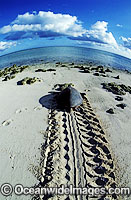
Nesting female Green sea turtle Chelonis
mydas returning to sea after nesting |
|
Sea turtles take many years to grow
to maturity. It is thought that a female turtle is around
fifty years old when she begins to mate and breed. When
her first breeding season finally comes around, she drags
herself up onto the beach, digs first a body pit and then
an egg chamber of around 50cm depth and lays an average
of 50 to 130 ping-pong ball sized eggs depending on the
species. Over the course of that one season she may repeat
the procedure up to eight times, laying a total of 500-1000
eggs. Of these maybe one or two will reach adulthood. Her
nesting season complete, the female will probably not mate
again for another three to six years.
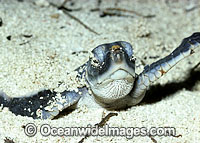 Green sea turtle hatchling Chelonis mydas
emerging from sand making way to
the sea.
Green sea turtle hatchling Chelonis mydas
emerging from sand making way to
the sea. |
|
The turtle eggs incubate in the sand
for around seven weeks during which time the embryos develop
into miniature turtles of 4 to 6 cm in length. Recent studies
have uncovered some astonishing facts about embryonic turtles.
The nest is in fact a complete micro-environment where factors
such as temperature, sand type, moisture and position on
the beach will affect the outcome of the eggs. The sex of
a turtle is not genetically determined at conception. When
the eggs are laid, the embryos within are sexless and whether
they turn out to be male or female depends entirely on the
temperature of the sand around the nest. If the sand is
27 degrees Celsius or cooler there will be more males and
if it is over 30 degrees, females will predominate. Thus,
some beaches produce greater numbers of one sex than others.
Though most of the eggs will develop into healthy baby turtles,
some will fall victim to crabs and infestation by fungus.
When the baby turtles hatch they spend
a few days in the sand, gradually making their way to the
surface and when the time is right (usually at night) they
emerge together and make an energetic dash down to the water.
It is by some innate sense that these tiny creatures, which
look something like wind-up bath toys, know exactly in which
direction the sea lies, even when it is obscured by ridges
or walls. They instinctively move toward the brightest light
source, which is normally the light area on the horizon.
They can be disorientated by artificial light, however,
so every effort is made at rookeries to educate the public
about the distraction unnecessary lights may cause. At least
90% of the hatchlings will escape birds and crabs to successfully
reach the water, but it is here in the sea that their journey
becomes perilous. The helpless little turtles are very easy
prey to many reef fish and sharks and most will not make
it across the reef flat.
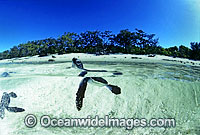 Green sea turtle hatchling Chelonis mydas
swimming in ocean
Green sea turtle hatchling Chelonis mydas
swimming in ocean |
|
When a newly hatched turtle leaves
its natal beach it is unlikely to be seen again until it
reaches around 30 cm in length and an estimated age of ten
to fifteen years. Where these young turtles spend the early
part of their lives is a complete mystery, though it is
speculated that they drift with ocean currents for great
distances and remain in the open ocean until they reach
a certain level of maturity.
Many scientists and volunteers will
dedicate many nights this summer to observing sea turtles
on Queensland beaches. The work they do is painstaking and
often tedious and they must brave all weather conditions.
The majority of people working for the Queensland Sea Turtle
Project are unpaid volunteers and it is only through the
tireless efforts of these people that we hopefully may be
able to learn enough about sea turtles to procure a safe
future for them.
Text: Sandra Eugarde
Photography: Gary Bell
|

